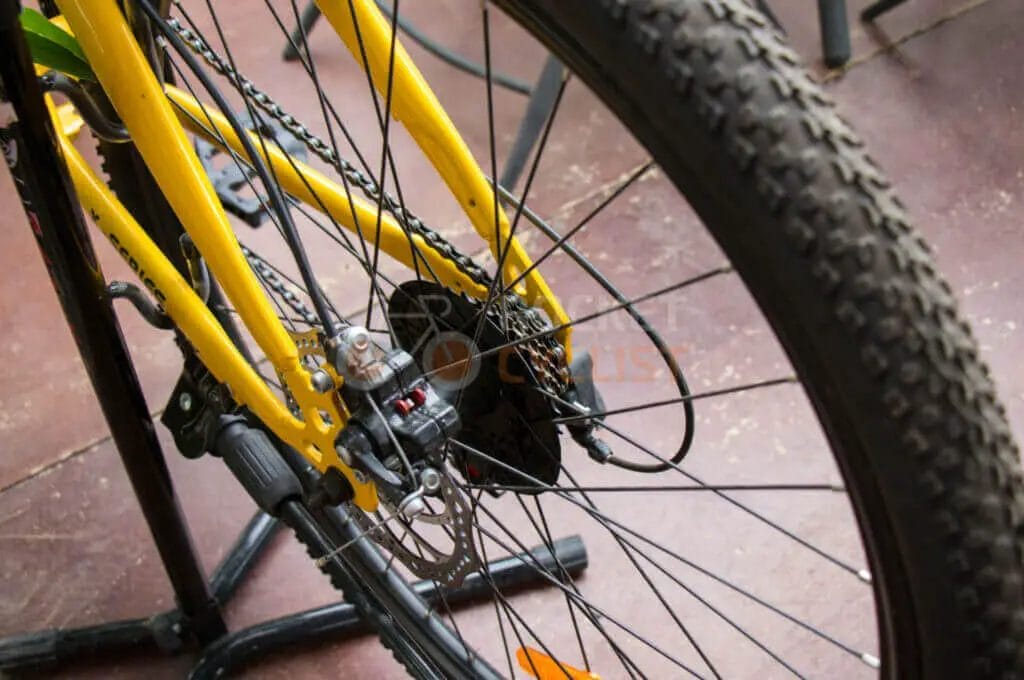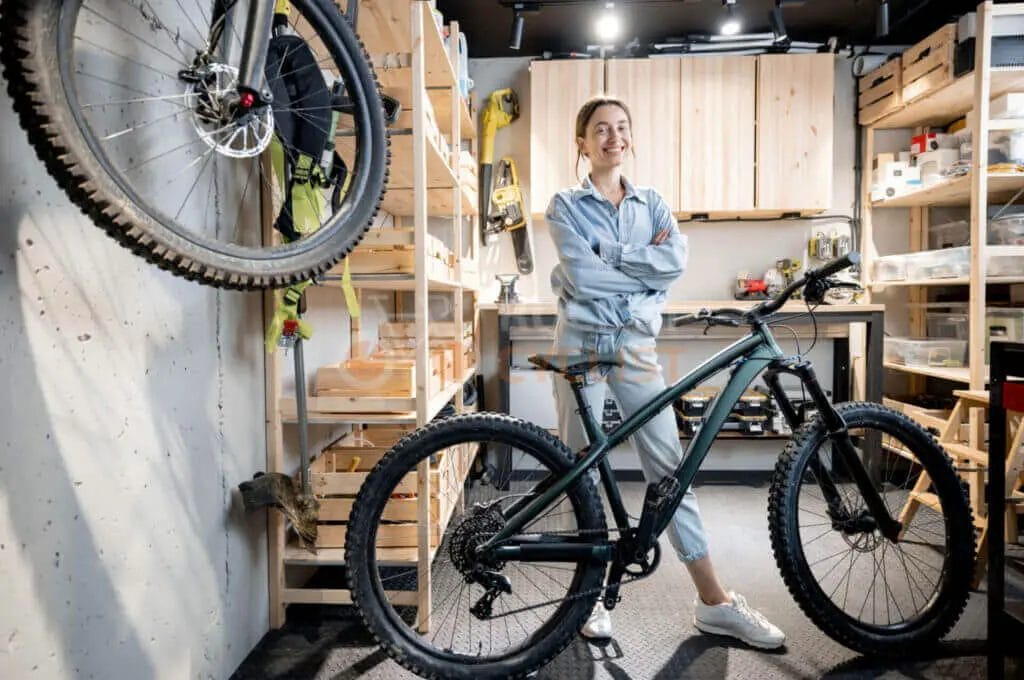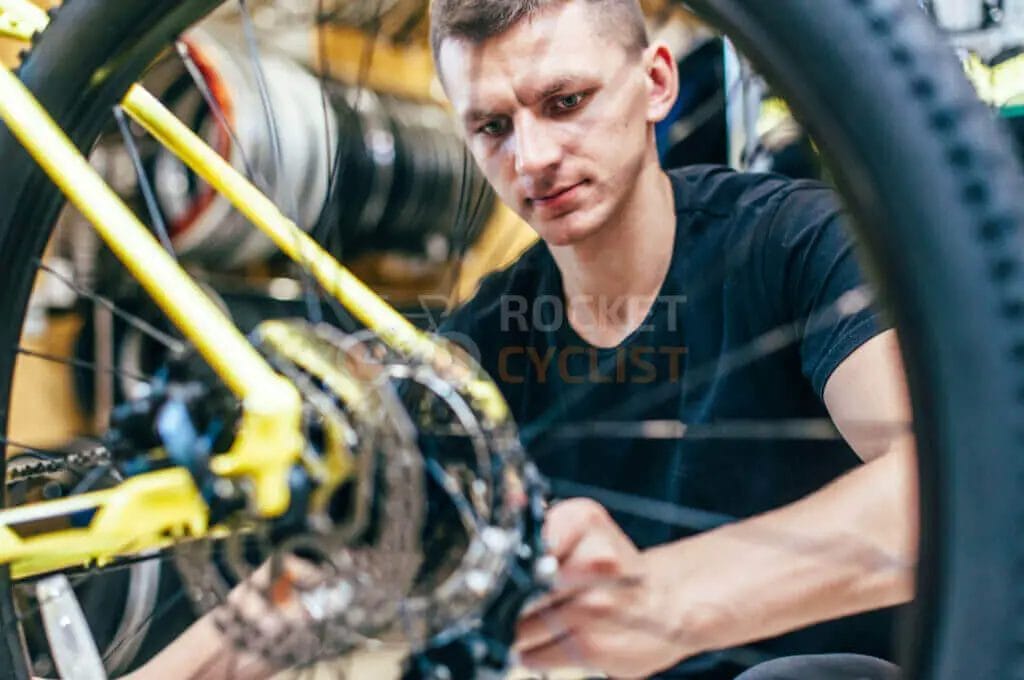Last Updated on February 12, 2024 by Vinson Lozano

When it comes to storing your bike, proper maintenance and care are essential to ensure its longevity and performance. One aspect to consider is the gear selection in which you store your bike. This may seem like a minor detail, but it can actually have an impact on the condition of your bike during storage. Understanding gear ratios and their effect on bike performance is key to making an informed decision. In this article, we will explore the importance of storing your bike properly, the role of gear selection in bike storage, and the benefits and potential risks associated with storing your bike in a specific gear.
Importance of storing your bike properly
Properly storing your bike is essential for its longevity and performance. When stored correctly, your bike is protected from damage, ensuring that it remains in top condition for your next ride. Storing your bike properly also helps to minimize the risk of rust, corrosion, and other forms of wear and tear. By taking the time to store your bike correctly, you can extend its lifespan and save yourself from costly repairs or replacements down the line. Proper storage also allows for easy access and organization, making it more convenient for you to grab your bike and hit the road whenever you’re ready.
The role of gear selection in bike storage
The role of gear selection in bike storage is crucial for the overall well-being of your bicycle. When it comes to long-term storage, it is generally recommended to store your bike in a specific gear. By doing so, you can minimize stress on the drivetrain, particularly the chain and cassette. Storing your bike in a higher gear, such as the largest rear cog and the smallest front chainring, can help alleviate tension on the chain and prevent it from becoming loose or potentially falling off. However, it is important to note that this may not be suitable for all types of bikes or storage spaces. Factors such as the type of drivetrain, bike model, and available storage space should be considered when selecting the appropriate gear for storage.
Understanding Gear Ratios
Understanding gear ratios is essential for bike enthusiasts who want to maximize their performance and storage capabilities. Gear ratios refer to the relationship between the number of teeth on the front chainring and the rear cassette cog. A higher gear ratio means more power and speed, while a lower gear ratio provides more torque for climbing or starting from a stop.
Gear ratios play a crucial role in bike performance and storage because they determine the effort required to pedal and the speed at which the bike moves. When it comes to storage, understanding gear ratios can help you choose the optimal gear for long-term storage, reducing tension on the drivetrain and ensuring the bike remains in top condition.
Brief explanation of gear ratios
Gear ratios refer to the relationship between the number of teeth on the front chainring and the rear cassette cog on your bike. It determines how many times the rear wheel rotates for each complete pedal revolution. For example, a gear ratio of 2:1 means that for every two rotations of the pedals, the rear wheel completes one rotation.
Gear ratios play a crucial role in determining the effort required to pedal and the speed at which your bike moves. Lower gear ratios provide more torque, making them ideal for climbing or starting from a stop, while higher gear ratios offer more speed and power for flat or downhill terrain.
Understanding gear ratios is essential because it helps you choose the optimal gear for storage, minimizing stress on the drivetrain and ensuring your bike remains in top condition.
How gear ratios affect bike performance and storage
Gear ratios have a significant impact on both bike performance and storage. By selecting the appropriate gear ratio, you can optimize your bike’s efficiency and minimize wear and tear during storage.
When it comes to performance, gear ratios determine the effort required to pedal and the speed at which your bike moves. Lower gear ratios provide more torque, making them ideal for climbing or starting from a stop. On the other hand, higher gear ratios offer more speed and power for flat or downhill terrain.
In terms of storage, choosing the right gear ratio can help minimize stress on the drivetrain and keep your bike in excellent condition. By selecting a gear that aligns the chain in a linear fashion, you can prevent unnecessary strain on the chain and gears, reducing the risk of damage or misalignment during long-term storage.
By understanding gear ratios and choosing the appropriate gear for storage, you can ensure your bike remains in optimal condition and ready for your next ride.
Gear Selection for Bike Storage

When it comes to storing your bike, selecting the right gear is crucial for maintaining its condition. For long-term storage, it is recommended to store your bike in a moderate gear, such as the middle or smaller chainring in the front and a middle gear in the rear cassette. This ensures that the chain is not overly tensioned, preventing unnecessary strain on the drivetrain. It also helps to keep the gear in a straight line, reducing the risk of misalignment during storage.
For short-term storage, you may consider leaving your bike in the gear you last used, as long as it is not too extreme. However, it’s always a good practice to shift to a moderate gear to minimize stress on the drivetrain. By selecting the appropriate gear for storage, you can ensure the longevity and performance of your bike.
Recommended gear for long-term storage
When it comes to long-term bike storage, it is recommended to store your bike in a moderate gear. This means selecting the middle or smaller chainring in the front and a middle gear in the rear cassette. By doing so, you ensure that the chain is not overly tensioned, which prevents unnecessary strain on the drivetrain components.
Storing your bike in a moderate gear also helps to keep the gear in a straight line, reducing the risk of misalignment during storage. This is important because misalignment can lead to shifting issues and potential damage to the derailleur.
By following this recommendation, you can maintain the condition of your bike and prolong the lifespan of your drivetrain components.
Alternatives to consider for short-term storage
When it comes to short-term storage of your bike, there are a few alternatives to consider if you don’t want to leave it in a specific gear. These alternatives can help minimize strain on the drivetrain while still keeping your bike in good condition.
One option is to simply shift to the gear that feels most comfortable to you, ensuring that the chain is not overly tensioned. Another option is to shift to the smallest chainring and the smallest gear in the rear cassette, as this reduces the strain on the drivetrain even further.
Regardless of the option you choose, it’s important to ensure that your bike is in a gear that allows for a relatively straight chain line. This will help prevent misalignment and potential damage to the derailleur. Remember to adjust the gear before storing your bike and to regularly check and maintain it to ensure optimal performance.
Benefits of Storing Your Bike in a Specific Gear
When it comes to storing your bike, keeping it in a specific gear can offer several benefits. First and foremost, storing your bike in a specific gear helps minimize stress on the drivetrain, particularly the chain and derailleur. This can prevent unnecessary wear and tear on these components, ensuring they remain in good condition during storage.
Additionally, storing your bike in a specific gear improves the overall condition of your bike. By selecting a gear that provides a relatively straight chain line, you can avoid misalignment issues and potential damage to the derailleur. This means your bike will be ready to ride smoothly when you’re ready to use it again.
To ensure optimal performance, it is recommended to periodically check and maintain the gear you have selected for storage to prevent any potential issues. By storing your bike in a specific gear, you can prolong the lifespan of your components and maintain the integrity of your bike.
Minimizing stress on the drivetrain
When it comes to storing your bike, it’s important to minimize stress on the drivetrain, which includes the chain and derailleur. By storing your bike in a specific gear, you can achieve this.
When the bike is in a specific gear, the chain is aligned and doesn’t experience unnecessary tension. This reduces the risk of the chain slipping or coming off during storage. Additionally, the derailleur is also in a position that doesn’t put strain on its components.
By minimizing stress on the drivetrain, you can avoid excessive wear and tear, prolonging the lifespan of these crucial components. This means your bike will be in better condition when you’re ready to ride it again. So, remember to select an appropriate gear and take care of your bike’s drivetrain during storage.
Improving overall bike condition during storage
During storage, storing your bike in a specific gear can greatly improve its overall condition. By selecting an appropriate gear, you can minimize stress on the drivetrain, including the chain and derailleur. This reduces the risk of the chain slipping or coming off, preventing unnecessary wear and tear. Additionally, the drivetrain components are positioned in a way that doesn’t strain them, prolonging their lifespan.
By taking proper care of your bike’s drivetrain, you’ll ensure that it remains in optimal condition during storage. This means that when you’re ready to ride your bike again, it will be in good shape and ready to hit the road. So, remember to select the right gear for storage to improve the overall condition of your bike.
Potential Risks and Considerations
When considering storing your bike in a specific gear, it’s important to be aware of potential risks and considerations. While storing your bike in a gear can help maintain its condition, there are some potential issues to keep in mind. Leaving your bike in the same gear for an extended period can cause the chain and drivetrain components to become stiff or locked in place. This can result in difficulty shifting gears or even damage to the drivetrain. Additionally, extreme temperatures or humidity levels in the storage area can affect the lubrication and performance of the drivetrain. It’s important to regularly check and maintain your bike’s condition during storage to prevent these issues.
Potential issues with leaving your bike in a specific gear for extended periods
When leaving your bike in a specific gear for an extended period, there are some potential issues to be aware of. One major concern is that the chain and drivetrain components could become stiff or locked in place. This can lead to difficulty shifting gears or even damage to the drivetrain when you eventually try to ride the bike again. It’s important to regularly check and maintain your bike’s condition during storage to prevent these issues. Additionally, extreme temperatures or humidity levels in the storage area can affect the lubrication and performance of the drivetrain. So, it’s crucial to store your bike in a controlled environment to minimize these risks.
Factors to consider when choosing the appropriate gear for storage

When choosing the appropriate gear for storage, there are a few factors to consider. First, you should take into account the length of time your bike will be stored. If it’s for a longer period, it’s recommended to choose a middle gear that provides a balance between tension and flexibility.
Second, consider the terrain you ride on regularly. If you typically ride on flat surfaces, a higher gear might be suitable for storage. On the other hand, if you often encounter steep inclines, a lower gear may be more appropriate to reduce stress on the drivetrain.
Lastly, consider your personal preferences and needs. If you have specific concerns about your bike’s performance or components, consult a bike expert who can provide tailored advice. Remember, choosing the right gear for storage can help preserve the condition of your bike and ensure a smooth ride when you’re ready to hit the road again.
Conclusion
In conclusion, storing your bike in a specific gear can have its benefits but also comes with potential risks. It is important to understand gear ratios and how they affect your bike’s performance and storage. For long-term storage, it is recommended to choose a middle gear that provides a balance between tension and flexibility. This helps minimize stress on the drivetrain and improves the overall condition of your bike during storage. However, it is essential to consider the length of storage time, terrain, and personal preferences when selecting the appropriate gear. Consulting a bike expert can provide tailored advice for your specific bike and concerns. Remember, proper bike storage is crucial to maintain its performance and longevity.
Importance of proper bike storage
Proper bike storage is essential for maintaining the performance and longevity of your bike. Here’s why it is important:
- Prevents damage: Storing your bike in a specific gear helps prevent the chain from becoming loose or tangled, reducing the risk of damage.
- Preserves drivetrain integrity: By keeping your bike in a specific gear, you minimize stress on the drivetrain, extending its lifespan and reducing the need for frequent repairs or replacements.
- Saves time and money: Proper storage reduces the likelihood of costly repairs or component replacements, saving you time and money in the long run.
- Ready to ride: Storing your bike properly ensures that it is ready to ride whenever you want without the hassle of fixing issues caused by improper storage.
By understanding the importance of proper bike storage and applying the right techniques, you can enjoy a bike that performs efficiently and lasts longer.
Practical tips and recommendations for storing your bike in a specific gear
When it comes to storing your bike in a specific gear, here are some practical tips and recommendations to keep in mind:
- Choose a gear that provides medium tension on the chain, neither too loose nor too tight. This helps maintain the drivetrain integrity without unnecessary strain.
- Consider using a gear that allows the chain to be in a straight line, minimizing stress on the chain and cassette.
- If you are storing your bike for a longer period, it is recommended to shift to a higher gear. This relieves tension on the suspension, preventing it from sagging over time.
- Make sure to clean and lubricate your chain before storing the bike to prevent rust and maintain optimal performance.
- Store your bike in a cool and dry place, away from direct sunlight and moisture. This helps preserve the condition of the components.
By following these tips, you can ensure that your bike remains in good shape during storage and is ready for your next adventure.


